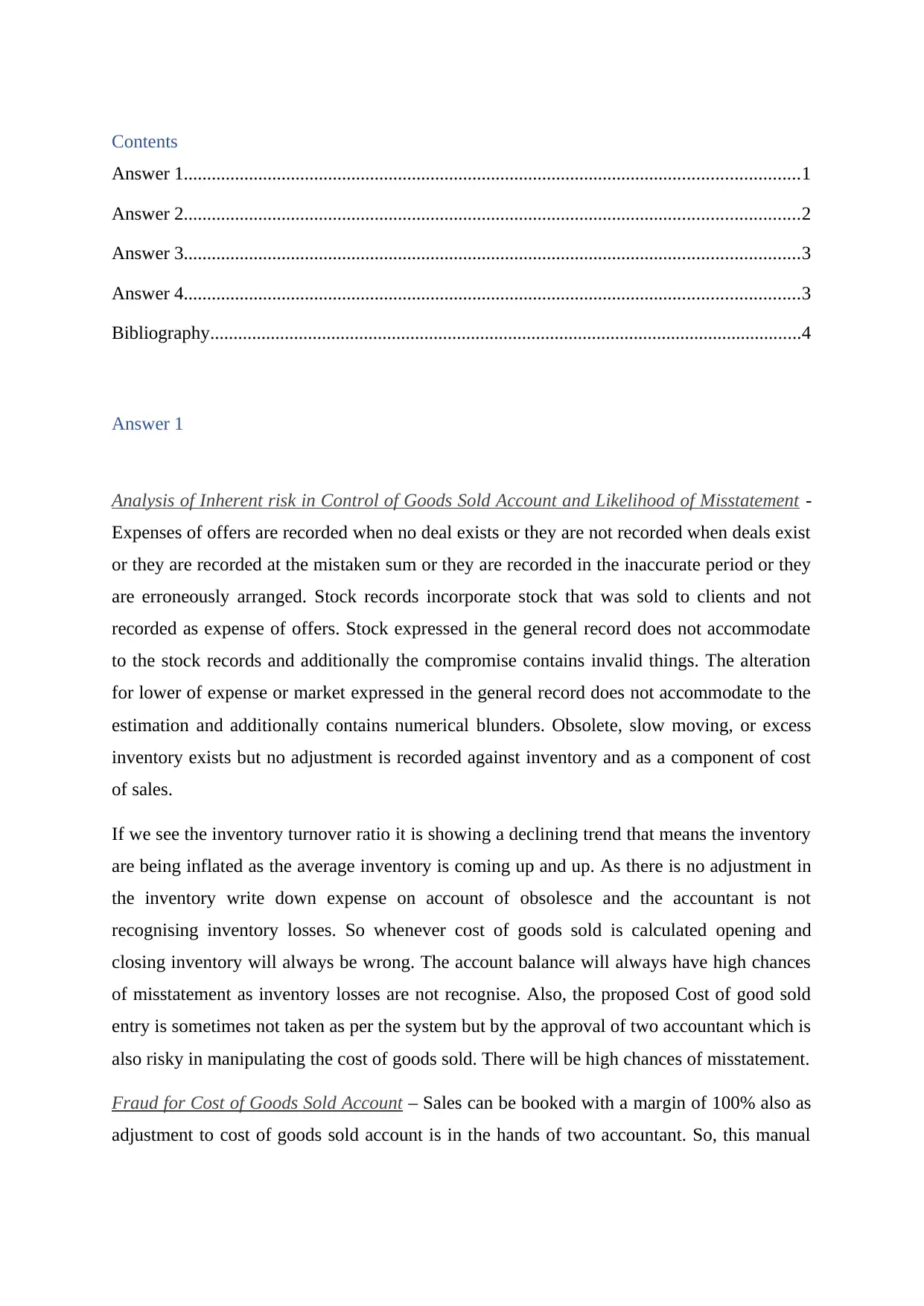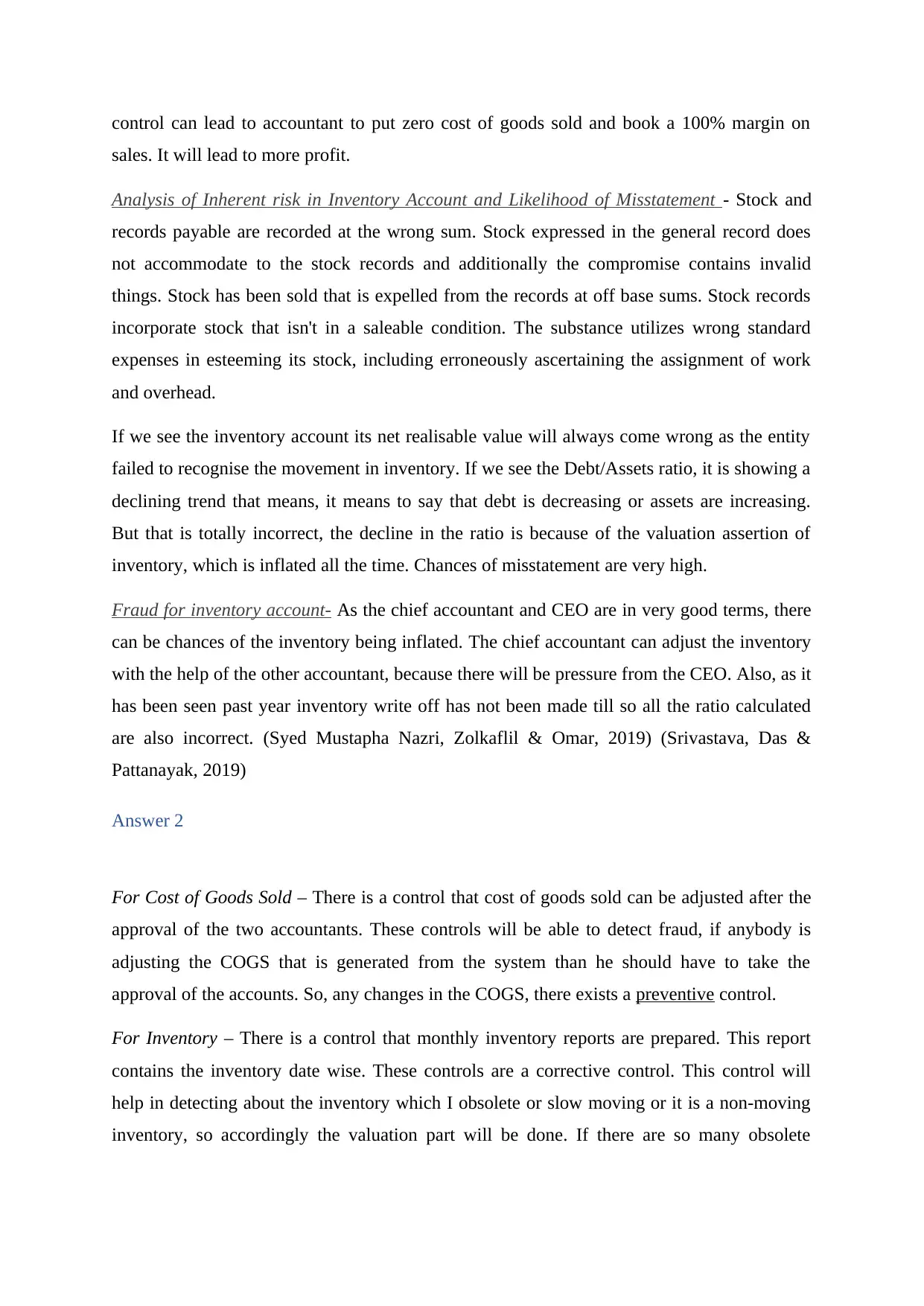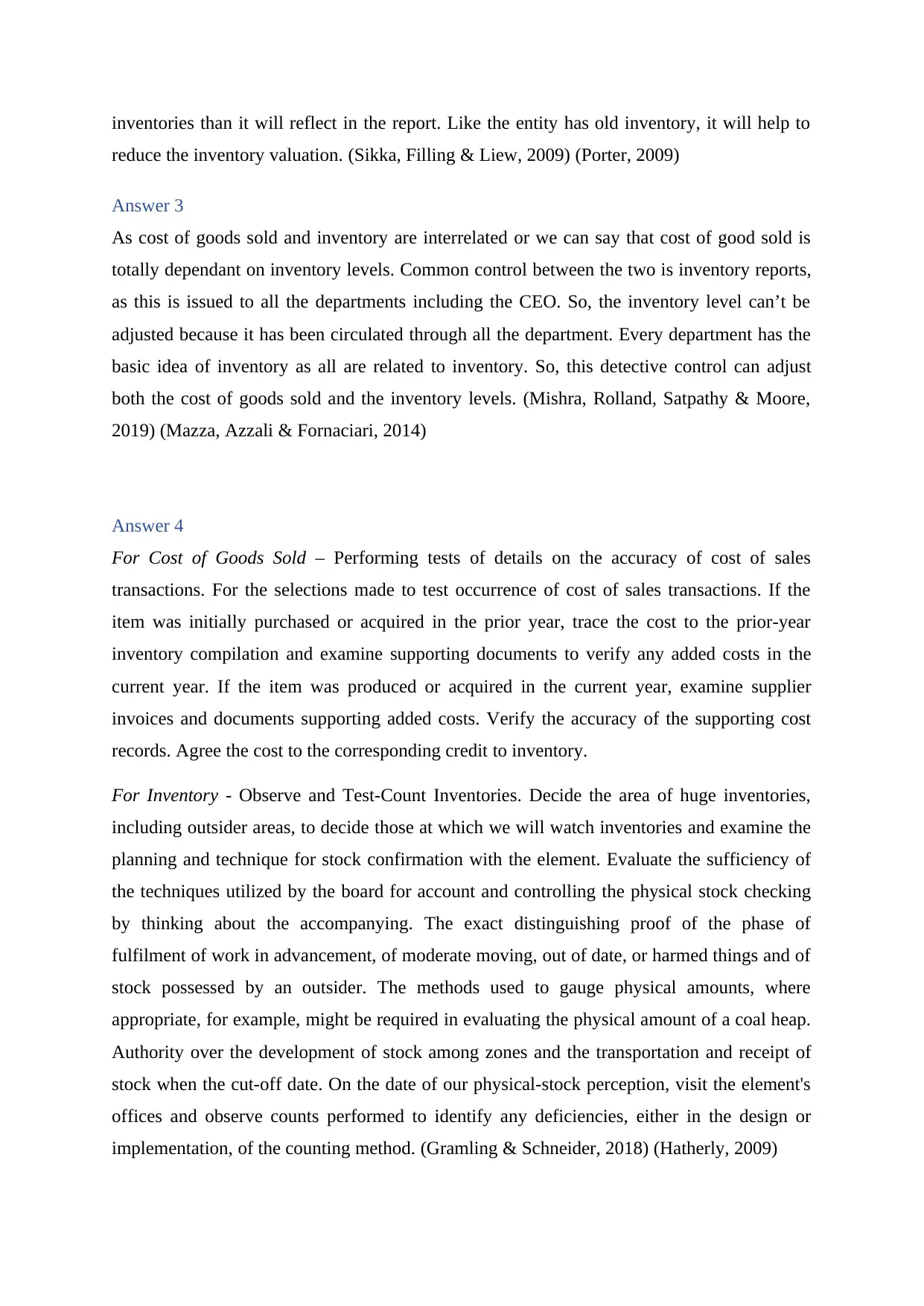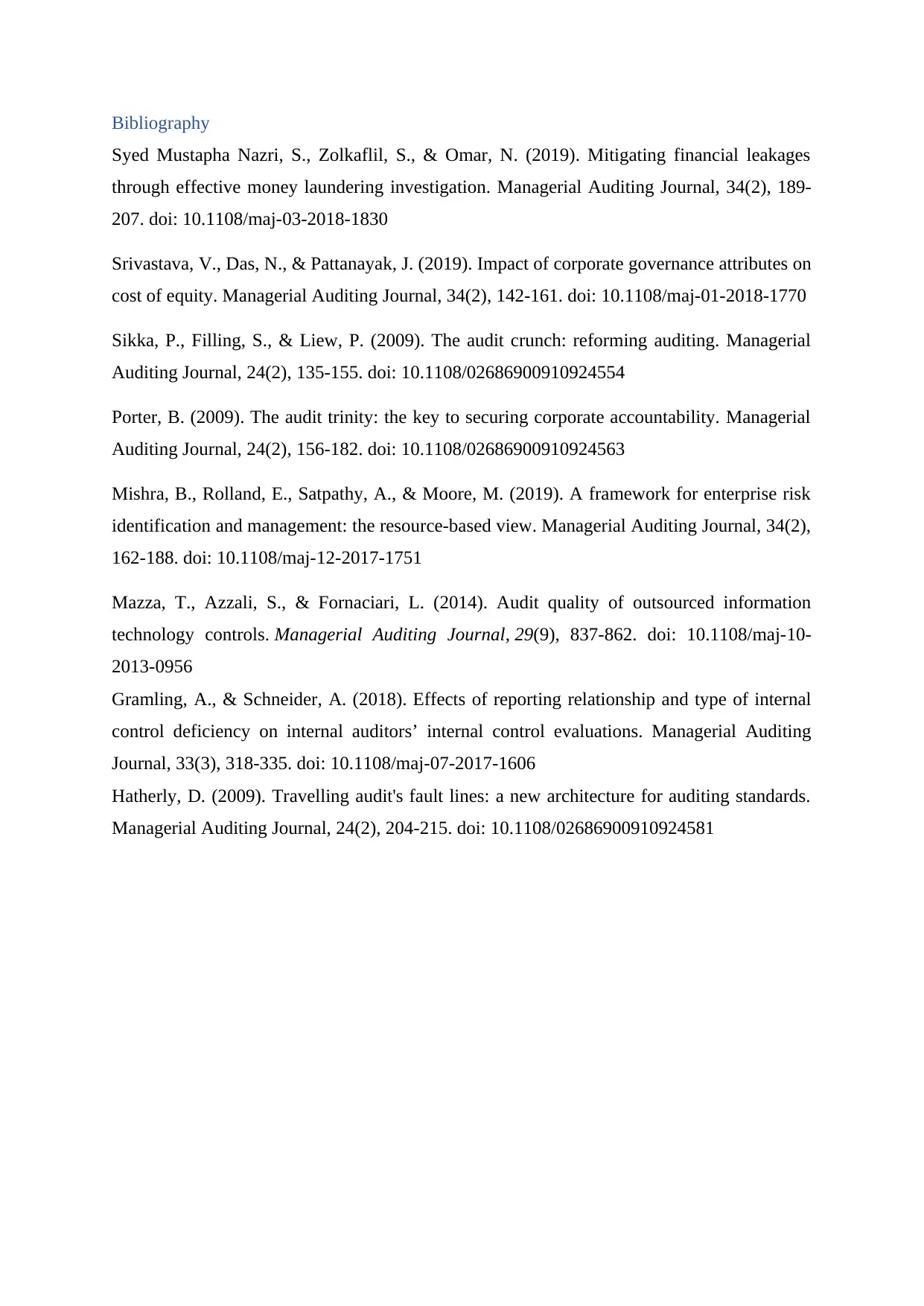ACCT3101 - Auditing Case Study: OfficeTech Ltd Audit Risk Analysis
VerifiedAdded on 2023/03/20
|5
|1547
|89
Case Study
AI Summary
This case study analyzes the audit of OfficeTech Limited, a company manufacturing office furniture and equipment, focusing on the financial year ending December 31, 2018. The analysis assesses inherent and control risks related to the cost of goods sold (COGS) and inventory accounts. The study ...

Contents
Answer 1....................................................................................................................................1
Answer 2....................................................................................................................................2
Answer 3....................................................................................................................................3
Answer 4....................................................................................................................................3
Bibliography...............................................................................................................................4
Answer 1
Analysis of Inherent risk in Control of Goods Sold Account and Likelihood of Misstatement -
Expenses of offers are recorded when no deal exists or they are not recorded when deals exist
or they are recorded at the mistaken sum or they are recorded in the inaccurate period or they
are erroneously arranged. Stock records incorporate stock that was sold to clients and not
recorded as expense of offers. Stock expressed in the general record does not accommodate
to the stock records and additionally the compromise contains invalid things. The alteration
for lower of expense or market expressed in the general record does not accommodate to the
estimation and additionally contains numerical blunders. Obsolete, slow moving, or excess
inventory exists but no adjustment is recorded against inventory and as a component of cost
of sales.
If we see the inventory turnover ratio it is showing a declining trend that means the inventory
are being inflated as the average inventory is coming up and up. As there is no adjustment in
the inventory write down expense on account of obsolesce and the accountant is not
recognising inventory losses. So whenever cost of goods sold is calculated opening and
closing inventory will always be wrong. The account balance will always have high chances
of misstatement as inventory losses are not recognise. Also, the proposed Cost of good sold
entry is sometimes not taken as per the system but by the approval of two accountant which is
also risky in manipulating the cost of goods sold. There will be high chances of misstatement.
Fraud for Cost of Goods Sold Account – Sales can be booked with a margin of 100% also as
adjustment to cost of goods sold account is in the hands of two accountant. So, this manual
Answer 1....................................................................................................................................1
Answer 2....................................................................................................................................2
Answer 3....................................................................................................................................3
Answer 4....................................................................................................................................3
Bibliography...............................................................................................................................4
Answer 1
Analysis of Inherent risk in Control of Goods Sold Account and Likelihood of Misstatement -
Expenses of offers are recorded when no deal exists or they are not recorded when deals exist
or they are recorded at the mistaken sum or they are recorded in the inaccurate period or they
are erroneously arranged. Stock records incorporate stock that was sold to clients and not
recorded as expense of offers. Stock expressed in the general record does not accommodate
to the stock records and additionally the compromise contains invalid things. The alteration
for lower of expense or market expressed in the general record does not accommodate to the
estimation and additionally contains numerical blunders. Obsolete, slow moving, or excess
inventory exists but no adjustment is recorded against inventory and as a component of cost
of sales.
If we see the inventory turnover ratio it is showing a declining trend that means the inventory
are being inflated as the average inventory is coming up and up. As there is no adjustment in
the inventory write down expense on account of obsolesce and the accountant is not
recognising inventory losses. So whenever cost of goods sold is calculated opening and
closing inventory will always be wrong. The account balance will always have high chances
of misstatement as inventory losses are not recognise. Also, the proposed Cost of good sold
entry is sometimes not taken as per the system but by the approval of two accountant which is
also risky in manipulating the cost of goods sold. There will be high chances of misstatement.
Fraud for Cost of Goods Sold Account – Sales can be booked with a margin of 100% also as
adjustment to cost of goods sold account is in the hands of two accountant. So, this manual
Paraphrase This Document
Need a fresh take? Get an instant paraphrase of this document with our AI Paraphraser

control can lead to accountant to put zero cost of goods sold and book a 100% margin on
sales. It will lead to more profit.
Analysis of Inherent risk in Inventory Account and Likelihood of Misstatement - Stock and
records payable are recorded at the wrong sum. Stock expressed in the general record does
not accommodate to the stock records and additionally the compromise contains invalid
things. Stock has been sold that is expelled from the records at off base sums. Stock records
incorporate stock that isn't in a saleable condition. The substance utilizes wrong standard
expenses in esteeming its stock, including erroneously ascertaining the assignment of work
and overhead.
If we see the inventory account its net realisable value will always come wrong as the entity
failed to recognise the movement in inventory. If we see the Debt/Assets ratio, it is showing a
declining trend that means, it means to say that debt is decreasing or assets are increasing.
But that is totally incorrect, the decline in the ratio is because of the valuation assertion of
inventory, which is inflated all the time. Chances of misstatement are very high.
Fraud for inventory account- As the chief accountant and CEO are in very good terms, there
can be chances of the inventory being inflated. The chief accountant can adjust the inventory
with the help of the other accountant, because there will be pressure from the CEO. Also, as it
has been seen past year inventory write off has not been made till so all the ratio calculated
are also incorrect. (Syed Mustapha Nazri, Zolkaflil & Omar, 2019) (Srivastava, Das &
Pattanayak, 2019)
Answer 2
For Cost of Goods Sold – There is a control that cost of goods sold can be adjusted after the
approval of the two accountants. These controls will be able to detect fraud, if anybody is
adjusting the COGS that is generated from the system than he should have to take the
approval of the accounts. So, any changes in the COGS, there exists a preventive control.
For Inventory – There is a control that monthly inventory reports are prepared. This report
contains the inventory date wise. These controls are a corrective control. This control will
help in detecting about the inventory which I obsolete or slow moving or it is a non-moving
inventory, so accordingly the valuation part will be done. If there are so many obsolete
sales. It will lead to more profit.
Analysis of Inherent risk in Inventory Account and Likelihood of Misstatement - Stock and
records payable are recorded at the wrong sum. Stock expressed in the general record does
not accommodate to the stock records and additionally the compromise contains invalid
things. Stock has been sold that is expelled from the records at off base sums. Stock records
incorporate stock that isn't in a saleable condition. The substance utilizes wrong standard
expenses in esteeming its stock, including erroneously ascertaining the assignment of work
and overhead.
If we see the inventory account its net realisable value will always come wrong as the entity
failed to recognise the movement in inventory. If we see the Debt/Assets ratio, it is showing a
declining trend that means, it means to say that debt is decreasing or assets are increasing.
But that is totally incorrect, the decline in the ratio is because of the valuation assertion of
inventory, which is inflated all the time. Chances of misstatement are very high.
Fraud for inventory account- As the chief accountant and CEO are in very good terms, there
can be chances of the inventory being inflated. The chief accountant can adjust the inventory
with the help of the other accountant, because there will be pressure from the CEO. Also, as it
has been seen past year inventory write off has not been made till so all the ratio calculated
are also incorrect. (Syed Mustapha Nazri, Zolkaflil & Omar, 2019) (Srivastava, Das &
Pattanayak, 2019)
Answer 2
For Cost of Goods Sold – There is a control that cost of goods sold can be adjusted after the
approval of the two accountants. These controls will be able to detect fraud, if anybody is
adjusting the COGS that is generated from the system than he should have to take the
approval of the accounts. So, any changes in the COGS, there exists a preventive control.
For Inventory – There is a control that monthly inventory reports are prepared. This report
contains the inventory date wise. These controls are a corrective control. This control will
help in detecting about the inventory which I obsolete or slow moving or it is a non-moving
inventory, so accordingly the valuation part will be done. If there are so many obsolete

inventories than it will reflect in the report. Like the entity has old inventory, it will help to
reduce the inventory valuation. (Sikka, Filling & Liew, 2009) (Porter, 2009)
Answer 3
As cost of goods sold and inventory are interrelated or we can say that cost of good sold is
totally dependant on inventory levels. Common control between the two is inventory reports,
as this is issued to all the departments including the CEO. So, the inventory level can’t be
adjusted because it has been circulated through all the department. Every department has the
basic idea of inventory as all are related to inventory. So, this detective control can adjust
both the cost of goods sold and the inventory levels. (Mishra, Rolland, Satpathy & Moore,
2019) (Mazza, Azzali & Fornaciari, 2014)
Answer 4
For Cost of Goods Sold – Performing tests of details on the accuracy of cost of sales
transactions. For the selections made to test occurrence of cost of sales transactions. If the
item was initially purchased or acquired in the prior year, trace the cost to the prior-year
inventory compilation and examine supporting documents to verify any added costs in the
current year. If the item was produced or acquired in the current year, examine supplier
invoices and documents supporting added costs. Verify the accuracy of the supporting cost
records. Agree the cost to the corresponding credit to inventory.
For Inventory - Observe and Test-Count Inventories. Decide the area of huge inventories,
including outsider areas, to decide those at which we will watch inventories and examine the
planning and technique for stock confirmation with the element. Evaluate the sufficiency of
the techniques utilized by the board for account and controlling the physical stock checking
by thinking about the accompanying. The exact distinguishing proof of the phase of
fulfilment of work in advancement, of moderate moving, out of date, or harmed things and of
stock possessed by an outsider. The methods used to gauge physical amounts, where
appropriate, for example, might be required in evaluating the physical amount of a coal heap.
Authority over the development of stock among zones and the transportation and receipt of
stock when the cut-off date. On the date of our physical-stock perception, visit the element's
offices and observe counts performed to identify any deficiencies, either in the design or
implementation, of the counting method. (Gramling & Schneider, 2018) (Hatherly, 2009)
reduce the inventory valuation. (Sikka, Filling & Liew, 2009) (Porter, 2009)
Answer 3
As cost of goods sold and inventory are interrelated or we can say that cost of good sold is
totally dependant on inventory levels. Common control between the two is inventory reports,
as this is issued to all the departments including the CEO. So, the inventory level can’t be
adjusted because it has been circulated through all the department. Every department has the
basic idea of inventory as all are related to inventory. So, this detective control can adjust
both the cost of goods sold and the inventory levels. (Mishra, Rolland, Satpathy & Moore,
2019) (Mazza, Azzali & Fornaciari, 2014)
Answer 4
For Cost of Goods Sold – Performing tests of details on the accuracy of cost of sales
transactions. For the selections made to test occurrence of cost of sales transactions. If the
item was initially purchased or acquired in the prior year, trace the cost to the prior-year
inventory compilation and examine supporting documents to verify any added costs in the
current year. If the item was produced or acquired in the current year, examine supplier
invoices and documents supporting added costs. Verify the accuracy of the supporting cost
records. Agree the cost to the corresponding credit to inventory.
For Inventory - Observe and Test-Count Inventories. Decide the area of huge inventories,
including outsider areas, to decide those at which we will watch inventories and examine the
planning and technique for stock confirmation with the element. Evaluate the sufficiency of
the techniques utilized by the board for account and controlling the physical stock checking
by thinking about the accompanying. The exact distinguishing proof of the phase of
fulfilment of work in advancement, of moderate moving, out of date, or harmed things and of
stock possessed by an outsider. The methods used to gauge physical amounts, where
appropriate, for example, might be required in evaluating the physical amount of a coal heap.
Authority over the development of stock among zones and the transportation and receipt of
stock when the cut-off date. On the date of our physical-stock perception, visit the element's
offices and observe counts performed to identify any deficiencies, either in the design or
implementation, of the counting method. (Gramling & Schneider, 2018) (Hatherly, 2009)
You're viewing a preview
Unlock full access by subscribing today!

Bibliography
Syed Mustapha Nazri, S., Zolkaflil, S., & Omar, N. (2019). Mitigating financial leakages
through effective money laundering investigation. Managerial Auditing Journal, 34(2), 189-
207. doi: 10.1108/maj-03-2018-1830
Srivastava, V., Das, N., & Pattanayak, J. (2019). Impact of corporate governance attributes on
cost of equity. Managerial Auditing Journal, 34(2), 142-161. doi: 10.1108/maj-01-2018-1770
Sikka, P., Filling, S., & Liew, P. (2009). The audit crunch: reforming auditing. Managerial
Auditing Journal, 24(2), 135-155. doi: 10.1108/02686900910924554
Porter, B. (2009). The audit trinity: the key to securing corporate accountability. Managerial
Auditing Journal, 24(2), 156-182. doi: 10.1108/02686900910924563
Mishra, B., Rolland, E., Satpathy, A., & Moore, M. (2019). A framework for enterprise risk
identification and management: the resource-based view. Managerial Auditing Journal, 34(2),
162-188. doi: 10.1108/maj-12-2017-1751
Mazza, T., Azzali, S., & Fornaciari, L. (2014). Audit quality of outsourced information
technology controls. Managerial Auditing Journal, 29(9), 837-862. doi: 10.1108/maj-10-
2013-0956
Gramling, A., & Schneider, A. (2018). Effects of reporting relationship and type of internal
control deficiency on internal auditors’ internal control evaluations. Managerial Auditing
Journal, 33(3), 318-335. doi: 10.1108/maj-07-2017-1606
Hatherly, D. (2009). Travelling audit's fault lines: a new architecture for auditing standards.
Managerial Auditing Journal, 24(2), 204-215. doi: 10.1108/02686900910924581
Syed Mustapha Nazri, S., Zolkaflil, S., & Omar, N. (2019). Mitigating financial leakages
through effective money laundering investigation. Managerial Auditing Journal, 34(2), 189-
207. doi: 10.1108/maj-03-2018-1830
Srivastava, V., Das, N., & Pattanayak, J. (2019). Impact of corporate governance attributes on
cost of equity. Managerial Auditing Journal, 34(2), 142-161. doi: 10.1108/maj-01-2018-1770
Sikka, P., Filling, S., & Liew, P. (2009). The audit crunch: reforming auditing. Managerial
Auditing Journal, 24(2), 135-155. doi: 10.1108/02686900910924554
Porter, B. (2009). The audit trinity: the key to securing corporate accountability. Managerial
Auditing Journal, 24(2), 156-182. doi: 10.1108/02686900910924563
Mishra, B., Rolland, E., Satpathy, A., & Moore, M. (2019). A framework for enterprise risk
identification and management: the resource-based view. Managerial Auditing Journal, 34(2),
162-188. doi: 10.1108/maj-12-2017-1751
Mazza, T., Azzali, S., & Fornaciari, L. (2014). Audit quality of outsourced information
technology controls. Managerial Auditing Journal, 29(9), 837-862. doi: 10.1108/maj-10-
2013-0956
Gramling, A., & Schneider, A. (2018). Effects of reporting relationship and type of internal
control deficiency on internal auditors’ internal control evaluations. Managerial Auditing
Journal, 33(3), 318-335. doi: 10.1108/maj-07-2017-1606
Hatherly, D. (2009). Travelling audit's fault lines: a new architecture for auditing standards.
Managerial Auditing Journal, 24(2), 204-215. doi: 10.1108/02686900910924581
Paraphrase This Document
Need a fresh take? Get an instant paraphrase of this document with our AI Paraphraser

1 out of 5
Your All-in-One AI-Powered Toolkit for Academic Success.
+13062052269
info@desklib.com
Available 24*7 on WhatsApp / Email
![[object Object]](/_next/static/media/star-bottom.7253800d.svg)
Unlock your academic potential
© 2024 | Zucol Services PVT LTD | All rights reserved.

